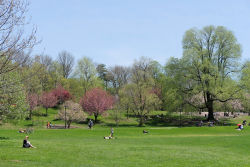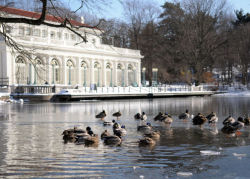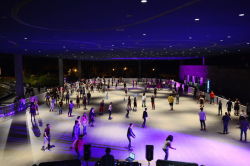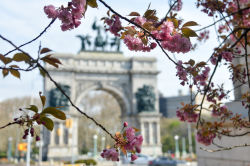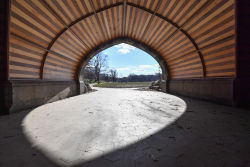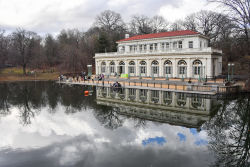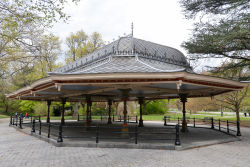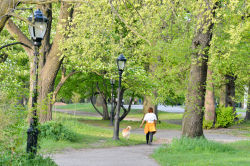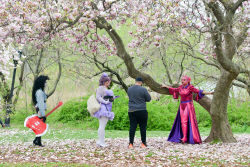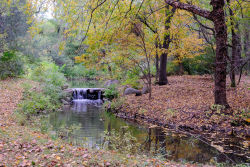Prospect Park
View all monuments in NYC Parks, as well as temporary public art installations on our NYC Public Art Map and Guide.
Thomas Moore Memorial
| Artist: | John G. Draddy |
| Dedicated: | May 28, 1879 |
| Location: | Flower Garden |
Artwork History
This bronze bust of the Irish poet Thomas Moore (1779–1852) was created by the American sculptor John G. Draddy (1833–1904). Draddy was born in Cincinnati, Ohio and had a prolific career. In New York City his work also includes the August Daly altar and Coleman Memorial in St. Patrick’s Cathedral. Dedicated in 1879 in the Concert Grove, this statue is one of seven in the immediate vicinity, including four portraits of composers.
Thomas Moore, born of humble origins in Dublin, Ireland on May 28, demonstrated precocious abilities in acting, singing, and writing verse. By the time he was admitted to Trinity College in 1794, he was already a published poet. In 1800, his translation of Odes of Anacreon brought him critical acclaim.
In 1801, under the pseudonym Thomas Little, he published his “poetical works,” a series of love poems. Appointed admiralty registrar of Bermuda in 1803, he returned two years later to England, after visits to the United States and Canada. He went on to have a prolific career as a poet and author of lyric songs, notably the Irish Melodies, published intermittently between 1808 and 1834, and National Airs (1818-1827). He also published a history of Ireland (1827) and a biography of Lord Byron (1830), and penned satirical pieces on contemporary society such as The Two Penny Postbag (1813) and The Fudge Family in Paris (1818).
The original plan of Prospect Park, designed by Frederick Law Olmsted (1822-1903) and Calvert Vaux (1824-1895) in 1866, left blank this area of the park, except for the written labels “Concourse for Pedestrians” and “Music Stand.” With the park under construction around 1870, Olmsted and Vaux elaborated their design to accommodate musical performances. Within an otherwise pastoral park, they set formal grounds with terraces and a radial arrangement of walkways, punctuated by lineally arranged trees, lavish floral beds, and elaborate decorative carvings in New Brunswick sandstone.
The Concert Grove House, demolished in 1949, embellished the north end, and at the southern tip Vaux designed the Concert Grove Pavilion, completed in 1874. Made of eight cast-iron posts modeled after Hindu columns of the medieval period (8th to 12th centuries), it supports an elaborately painted, hipped roof with stained-glass cupola. The structure, restored in 1987, is also known as the Oriental Pavilion and was at one time used as an open-air restaurant.
In 1887, the Music Pagoda was built near the Lily Pond, and with the subsequent establishment of a new music grove at the northern edge of the area of the park known as the Nethermead, this area came to be referred to as the Flower Garden.
The Concert Grove possesses a rich collection of bronze sculptural portraits. Three, Henry Baerer’s bust of Ludwig van Beethoven (1894), Augustus Mueller’s Wolfgang Amadeus Mozart (1897), and Chester Beach’s Carl Maria Von Weber (1909), were donated by the United German Singers of Brooklyn as trophies which they had won in the national Saengerfest choral competitions.
In 1879, the centennial of Moore’s birth, the St. Patrick Society of Brooklyn commissioned this statue. Another statue of Moore by Dennis B. Sheahan was dedicated in 1880 next to the pond at the southeast corner of Central Park. In 1999, this sculpture was conserved by the City Parks Foundation Monuments Conservation Program, with funding from the Florence Gould Foundation.
Artwork Details
| Description: | Bust on ornamented pedestal |
| Materials: | Bronze, granite |
| Dimensions: | Bust H: 3'6"; Pedestal H: 9' W: 4'3" D: 4'3"; Pedestal ornament Diameter: 3' |
| Foundry: | P.E. Guerin |
| Donor: | St. Patrick Society of the City of Brooklyn |
| Cast: | ca 1879 |
Inscription
THOUGH GLORY BE GONE / AND THOUGH HOPE FADE AWAY / THY NAME, LOVEDERIN / SHALL LIVE IN HIS SONGS/
ERECTED BY THE / ST. PATRICK SOCIETY / OF THE CITY OF BROOKLYN / TO
COMMEMORATE THE / CENTENNIAL ANNIVERSARY / OF THE BIRTH OF / "THE
POET OF ALL CIRCLES AND / THE IDOL OF HIS OWN." / MAY 28, 1879/
Please note, the NAME field includes a primary designation as well as alternate namingsoften in common or popular usage. The DEDICATED field refers to the most recent dedication, most often, butnot necessarily the original dedication date. If the monument did not have a formal dedication, the yearlisted reflects the date of installation.
For more information, please contact Art & Antiquities at (212) 360-8163.
Check out your park's Vital Signs
Clean & Safe
Green & Resilient
Empowered & Engaged Users
Share your feedback or learn more about how this park is part of a
Vital Park System



